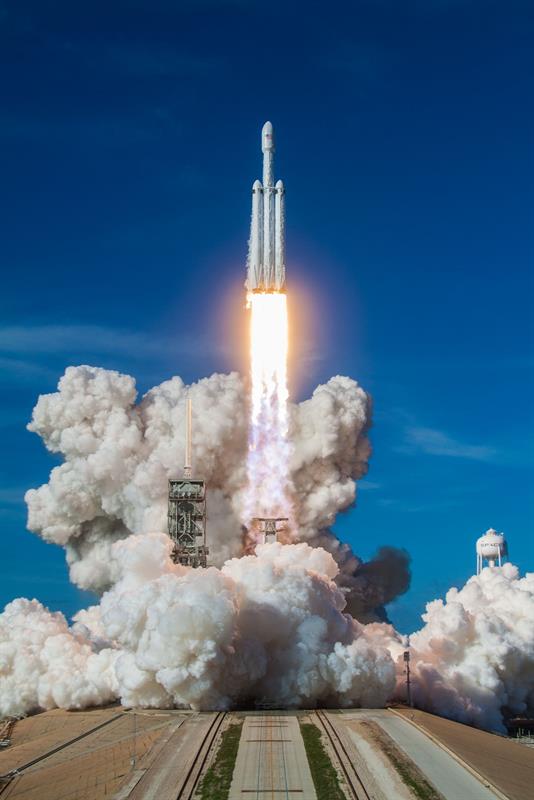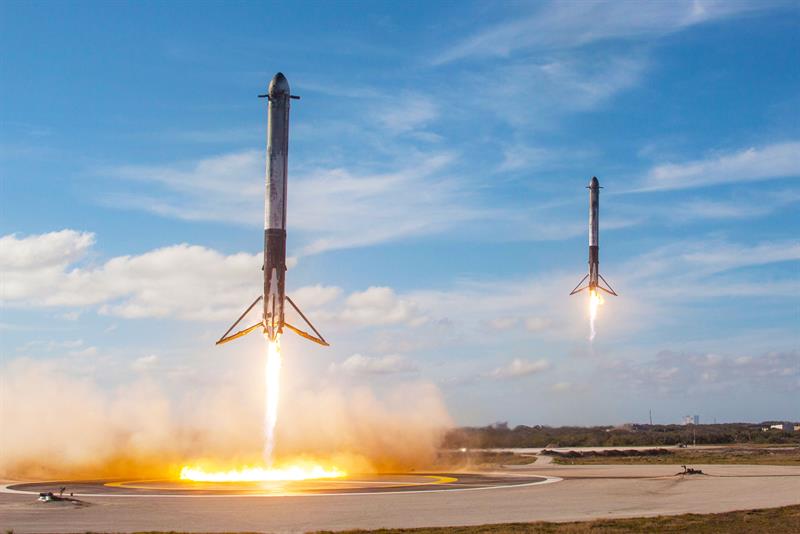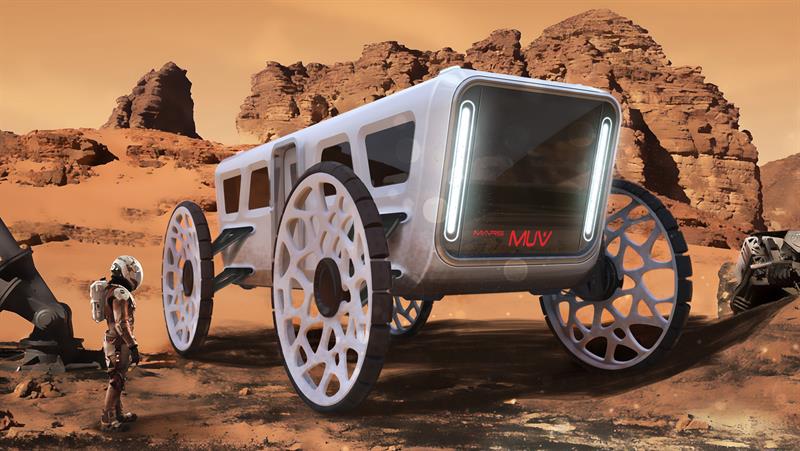For the first time since the early 1970s, space is cool again. As millions tuned in around the world, the bizarre crowning glory was a Tesla Roadster being ‘driven’ by a mannequin in a spacesuit. Elon Musk and SpaceX are a revelation to the space industry. You certainly wouldn’t get that with Nasa.
“It looks ridiculous,” says Musk in the post-flight press conference. “We didn’t test any of the materials, so it’s not space hardened. It is literally a normal car in space. Normally for a new rocket, they’d launch a block of concrete but that’s so boring. For imagery, it’s something that will get people excited around the world.”
Falcon Heavy impressed everyone from fanboys to media outlets that lapped up ‘Starman’. Even experienced engineers and scientists are amazed that Musk has been able to develop such a large reusable heavy-lift space system so quickly.
The ‘imagery’ signals that we should begin to believe that he’s not just serious about landing on the Moon and Mars, but he could soon be capable.
“Seeing the two boosters land synchronised, just like in the simulation, that could be a really scalable approach,” he says. “You can imagine large numbers of those just coming in and landing and doing many flights per day. It gives me a lot of faith for our next architecture, our interplanetary spaceship, BFR. It gives me confidence it is really quite workable and we can advance the technology to enable full and rapid reusability.”

Destination Mars
“We should have a lunar base by now,” he told the crowd at the International Astronautical Congress in September, last year. At the same conference, he explained plans to go to Mars in 2022 and land 400 people there starting from 2024. And in the post-flight celebratory press conference last month he quickly turned his attention once again to talking about how his recent triumph plays into his roadmap for Mars.
“We are almost done with Falcon 9 and Falcon Heavy,” he says. “Most of our engineering resources will now be dedicated to BFR. That will make things move quite quickly.”
BFR is aptly named: when built it will be 106m tall, similar in height to the biggest of them all, Saturn V. But, for Musk to both deliver on his promise, and make money, there are a number of key design goals that are easier said than done.
“It’s really crazy that [people] build these sophisticated rockets and then crash them every time they fly them,” says Musk. “This is mad. I can’t tell you how important reusability is.”
BFR will be capable of carrying a 150 ton payload, in an 825m3 container, with a diameter of 9m. In space terms that is a container ship. And like a container ship, it will dramatically reduce the costs of carrying freight.
BFR hopes to achieve a high degree of mission flexibility too, allowing commercial ventures like the ISS resupply to continue, as well as the deployment of satellites in various orbits. But, critically, it will allow Musk to pursue his own forays such as propelling the human-carrying module known as Dragon 2 to the Moon or Mars.
Tank development
The company is already off to a good start, developing and testing the ‘Deep Cryo Liquid Oxygen Tank’ for BFR, a key component as the rest of the rocket’s systems and engines will be built around it. It measures 12m in diameter and holds a volume of 1000m3.
A key breakthrough was in the materials technology. Using a prepreg carbon fibre reinforced polymer, the tank features a stronger matrix system that’s more stable at cryogenic temperatures. It was Lockheed Martin’s failure to create a viable carbon fibre tank in the 1990s that lead to the cancellation of the Shuttle’s potential replacement, the X-33, a single stage to orbit (SSTO) concept vehicle.
On to Mars

The principle approach for a mission to Mars hinges on the ability to refuel in space. That problem, Musk largely feels, has been solved with his fully automated docking system used for the ISS resupply module, Dragon.
Another key component is the heat shield. While this has long been a tricky design issue due to the severe ablation suffered by materials during re-entry, Musk hints at developing materials that could infact survive multiple planetary entries and re-entries.
“We really want to test the heat shield material with the Falcon Heavy,” says Musk. “So we’ll fly out, turn around, accelerate back real hard, and come in hot to test the heat shield as we want to have a highly reusable heat shield that’s capable of absorbing the heat from interplanetary entry velocities…. which is really tricky.
“I didn’t realise or think anything scaled to the 8th power. Turns out re-entry, and elements of re-entry heating scale at the 8th power.”
To the Moon
Falcon Heavy is not just a milestone, it is a breakthrough. It gives SpaceX the capability to make lunar orbits and no doubt before the Mars attempts in five years’ time, there will be unmanned and manned lunar orbits, landings on the moon and perhaps even the initialisation of a moon base.
“If we do a high elliptic parking orbit for the ship and ‘retank’ in high elliptic orbit, we can go all the way to the moon and back with no local propellant production on the moon,” he says. “That will enable the creation of moon base alpha, or some kind of lunar base.”
For Mars, however, there is a sticking point.
“We will need local propellant production,” says Musk. “But Mars has a CO2 atmosphere and plenty of water ice. That gives you CO2 and H2O, so you can make CH4 and O2 using the Sabatier process.
“The tricky thing with Mars is, we need to build a propellant depo to refill the tanks to return to Earth. But as Mars has lower gravity, you don’t need a booster, so you can go all the way from the surface of Mars to the surface of Earth using a single stage.”
Mars assist
SpaceX will not be alone when it comes to colonisation, however. The ongoing Mars Home Planet project, set up by HP along with its partners, is enticing engineers, architects and designers to create a virtual reality Martian colony. In its initial phase it looked at areas such as transportation and infrastructure as well as farming and even clothing, and asked how humankind could thrive on the Red Planet.
 The community-powered platform allows anyone to collaborate on ideas, solve problems and create solutions for challenges, both big and small, using an open innovation platform to accelerate the development process. In the first phase of Mars Home Planet, participants submitted conceptual designs for the buildings, vehicles, smart cities, and transportation systems that will support humans in an area of Mars called ‘Mars Valley’. The challenge was so popular, it attracted 34,000 participants and close to 500 entries.
The community-powered platform allows anyone to collaborate on ideas, solve problems and create solutions for challenges, both big and small, using an open innovation platform to accelerate the development process. In the first phase of Mars Home Planet, participants submitted conceptual designs for the buildings, vehicles, smart cities, and transportation systems that will support humans in an area of Mars called ‘Mars Valley’. The challenge was so popular, it attracted 34,000 participants and close to 500 entries.
“The idea is to get people engaged to come up with ideas about transportation and engineering to establish a life on the Mars,” says Sean Young, worldwide segment manager for product development and AEC at HP. “We will then take these models and bring them to life with VR, and it will be done using people that don’t know each other but that get together to make it all happen virtually.”
One of the winners was the MARS MUV, a multipurpose, easily adaptable vehicle. The vehicle is made modular so can work on its own, but can also link together to make a bus, or even be integrated as part of a railed transport system, allowing the vehicle to evolve with the planet’s terraforming efforts. The distinctive large wheels are designed to overcome obstacles on the Martian surface, and provide four-wheel steering for high manoeuvrability.
Reaching for the stars
The space industry has for so long felt stilted. And while reaching for the stars and the Red Planet have remained a fascination, there has been broad public acceptance that space bound capabilities beyond our own orbit will be limited to satellites and rovers. We have come to accept that it is just too expensive and dangerous to even contemplate. Thank goodness Elon Musk and SpaceX disagree.





